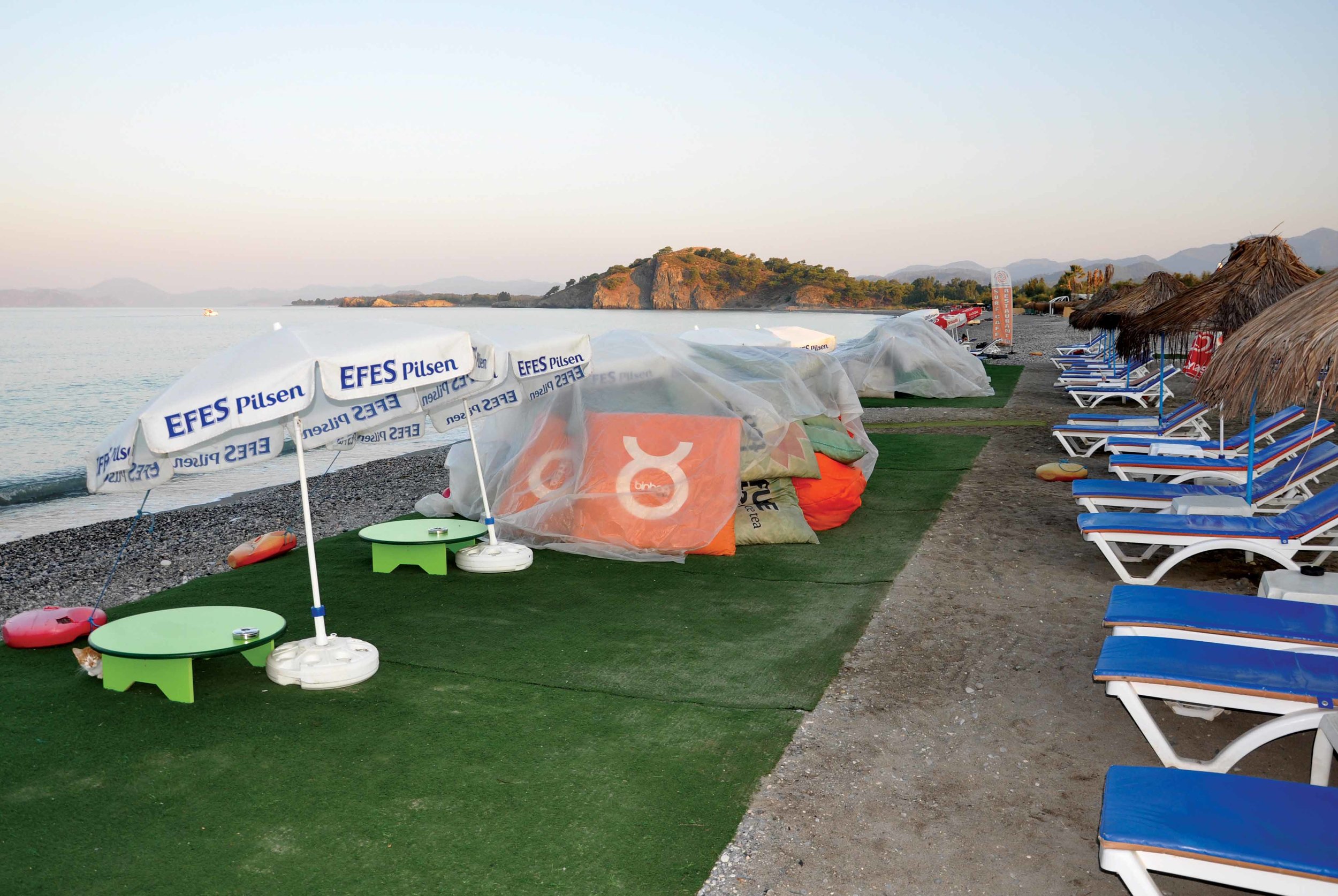Economic Recovery Takes Its Toll on Mediterranean Loggerheads
By Liza Boura, Kostis Grimanis, and Elli Sfyroera
With no management plan in place, beachfront businesses at Calis Beach, Fethiye, Turkey, are encroaching on valuable turtle nesting habitat. © MEDASSET (2013)
Over the past six years, coastal tourism and real estate development in the Mediterranean have gained new momentum as drivers for economic recovery among countries hit by the economic crisis. The governments of Greece, Cyprus, and Turkey are reshaping policies to attract investments. As a consequence, laws regulating land use and environmental impact assessments (EIAs) have been watered down. Greece and Turkey have drafted laws to open up protected areas to development, and environmental authorities have suffered staff cuts or reforms that weaken their powers. The European Union (EU), far from shouldering its green leadership role, is encouraging this trend toward deregulation and plans to revise legislation to remove “green tape” barriers to growth. The resurgence in coastal development is affecting loggerhead nesting sites in the Mediterranean, as shown in the following examples:
Greece – Kyparissia: The second most important loggerhead nesting site in the Mediterranean is protected by law but lacks a management plan. It has, nonetheless, been earmarked for a major vacation home development. Given the lack of political will to implement environmental regulations, developers have not been required to carry out an EIA and have already destroyed sand dunes and coastal forest to make way for the real estate project.
Turkey – Fethiye: With no management plan in place in this protected area, businesses are encroaching on the turtle nesting habitat and building along the shoreline, which has resulted in severe nesting declines. Uncontrolled development increased as Turkish institutional reforms led to weaker law enforcement and protected areas management.
Cyprus – Limni: Despite being a protected area, Limni beach is soon to be the site of the largest golf resort in the Mediterranean. Notwithstanding objections from nongovernmental organizations (NGOs) and scientists, authorities approved the project as part of the national development agenda. A 500-meter buffer zone was required between the planned 800 villas and the nesting beach, but authorities recently decided to reduce this zone to 20 meters with no justification.
The massive rollback in environmental agendas and lack of official control of development in Mediterranean countries must be met by the active involvement of civil society to help safeguard sea turtle nesting beaches. It is crucial that stakeholders, such as citizens, experts, and NGOs, monitor and react to legislative reforms and illegal or unsustainable investments on the ground in sensitive and high-priority areas for sea turtles. Scientific impact monitoring and the dissemination of results are essential ingredients of any advocacy effort. Raising awareness, especially about coastal ecosystem services and climate change, can also help change practices among business developers and the public.
To ensure a reasonable level of planning and consultation before development, getting protected status for sea turtle nesting beaches is a critical step. As the southern Mediterranean begins to join this growth surge following the Arab spring, we must have nesting beaches adequately protected before they are earmarked for development. The need for functional rather than “paper” protected areas cannot be overstated.
Volunteers measure a loggerhead nesting on Kyparissia beach in Greece. © Roderic Mast
At the policy level, efforts have been stepped up to ratify and implement the Integrated Coastal Zone Management Protocol developed at the 1976 Barcelona Convention. The 100-meter setback zone is undeniably one of the Protocol’s flagship provisions. Similarly, the EU is also in the process of adopting a new Directive on Maritime Spatial Planning and Integrated Coastal Management. Both are promising tools that can commit states to improving interagency and intersectoral coordination, enhancing stakeholder participation in management processes, and improving livelihoods through development that ensures biodiversity conservation. The ongoing review of the EU’s EIA Directive is far from being as ambitious as NGOs campaigned for, but its provisions in relation to biodiversity conservation were recently strengthened by the European Parliament, despite resistance by some European ministers.
The great leap forward is to ensure that these commitments and tools are put into practice and not shelved in times of financial crisis. Regardless, coastal development will continue to expand in the Mediterranean with more impacts on biodiversity. For example, tourism statistics predict that the number of visitors will increase from 200 million to more than 300 million by 2030. Part of the tourism sector is meeting this challenge by applying sustainable tourism best practices, which is positive but perhaps not enough to safeguard the natural capital on which tourism relies. Supported by NGOs and scientists, citizen action is also a promising ally against the coastal squeeze. Unlike the 20th-century coastal development trend, citizens are now better educated, have easier access to information, and have better tools to directly expose unsustainable development and put change-making pressure on developers and policymakers. We still have a long way to go to put our preaching into practice; hence, we must continue challenging the coastal development paradigms applied to date.
This article originally appeared in SWOT Report, vol. 9 (2014). Click here to download the entire article as a PDF.


